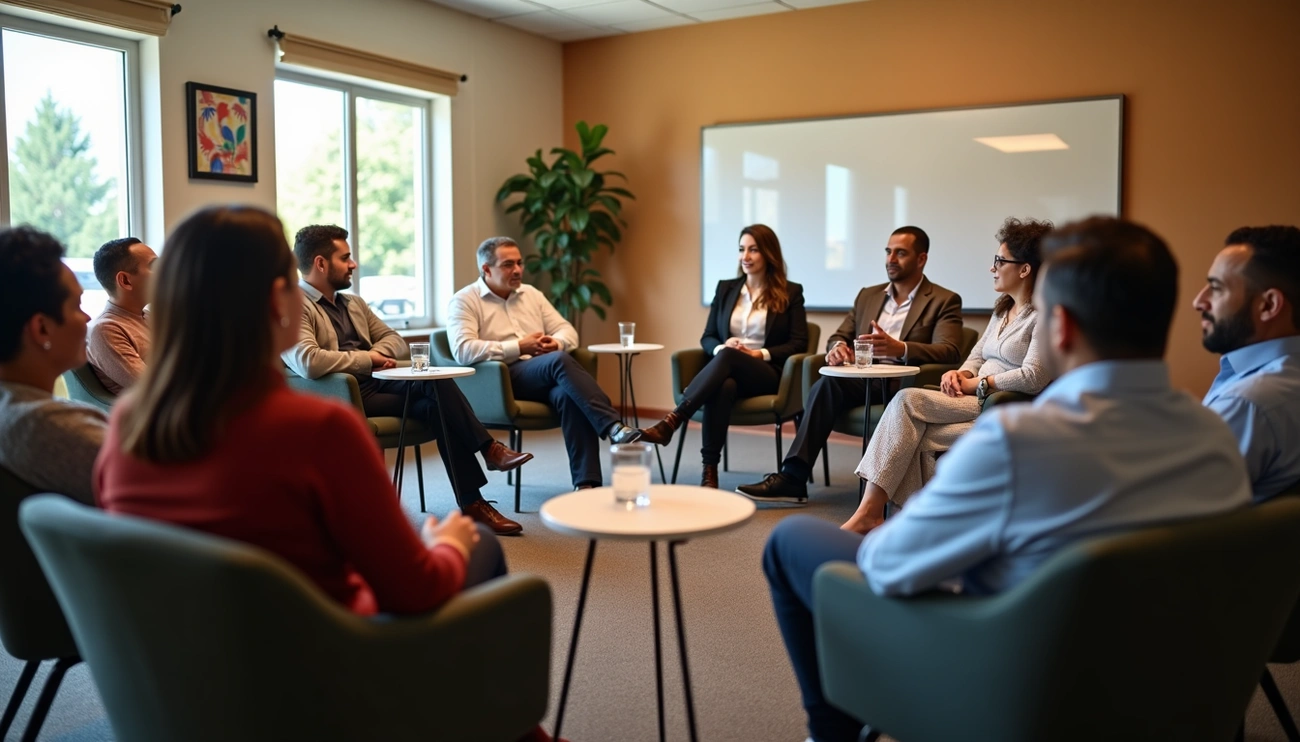Your cart is currently empty!
Trust remains a scarce commodity in many communities where only 30-40 percent of people trust others. This challenge becomes more complex in places like Los Angeles County with its 9.86 million residents and diversity that surpasses most American states. Service providers working in these varied communities can’t just treat trust as a nice-to-have—they need it to succeed.
Local communities feel the direct impact of authority decisions, which makes trust crucial at the neighborhood level. Underserved populations often struggle to build trust due to systemic inequities and discrimination they’ve faced. Healthcare data reveals a telling pattern: patients achieve better outcomes and communicate more effectively with providers who share their race and ethnicity. The numbers tell a stark story—only 5.7% of US doctors identify as Black compared to 13.7% of the population.
Organizations can build stronger trust by involving communities in meaningful ways. This approach leads to better cultural understanding and more effective policies. This piece takes a closer look at practical ways to build trust between communities and service providers. We’ll explore how to break down barriers and create lasting connections that enable everyone to participate.
Building Relationships and Engagement
Image Source: Indeed
Trust building starts with listening actively – you need to focus completely, understand, and respond meaningfully beyond just hearing words. Research shows this type of listening helps create deeper connections. People feel more valued and misunderstandings decrease when someone truly listens.
Providers and communities must do more than just make referrals to work together effectively. They just need mutually beneficial alliances with shared understanding and common goals. These relationships thrive on communication. Clear expectations about how often and how to stay in touch become crucial.
Meeting people “where they are” – both physically and mentally – creates stronger community bonds. Instead of waiting for residents to come to us, successful organizations build relationships through collaboration with community centers, religious institutions, and local events like farmers’ markets.
Trust grows stronger in safe community spaces. Organizations in Indiana created “core champions” – local members who earned neighborhood trust by showing their personal stake in outcomes. Rhode Island supporters took a similar approach. They listened carefully to community concerns before they started any programs.
Empathy forms the base of all these efforts. It lets us share and understand what others feel and intend. This emotional connection improves well-being. It also leads to better volunteer participation and helps create positive mental health outcomes.
Embodying Core Values of Trustworthiness
Image Source: Dreamstime.com
Actions, not just promises, build trust through core values that organizations must show consistently. Benevolence serves as the foundation of ethical service delivery – putting others’ needs first without expecting anything in return. Service providers need to build genuine relationships that go beyond simple transactions.
Public trust lives and breathes through transparency. Organizations that openly share details about their finances, governance and activities show their commitment to honesty. Communities willingly participate when organizations practice this openness, which leads to greater accountability through public oversight.
Making ethical choices based on human dignity defines integrity. Social workers who “behave in a trustworthy manner” stay focused on their profession’s mission and values. They know their limitations and refer clients to the right resources when needed.
Competence requires more than just proper credentials. Organizations must hire qualified staff, provide supervision, and look for the quickest ways to improve. Ethical responsibility demands better service delivery when current methods don’t work.
Creating spaces where people can be themselves makes community engagement authentic. This needs adequate resources, time and community-centered approaches that treat people as co-creators rather than just participants.
These core values help assistance providers build lasting trust. The relationship transforms from provider-recipient into genuine partnerships built on mutual respect and common goals.
Sharing Power and Addressing Barriers to Trust
Trust between communities and assistance providers faces a major challenge due to power imbalances. Building authentic trust requires organizations to share their decision-making power and create systems that respect each person’s independence.
Promoting choice remains crucial in support systems, especially when you have vulnerable populations. People need to make independent choices to strengthen their self-determination. These opportunities help them regain control over their surroundings. Care services should offer plenty of choices, and staff should teach choice-making skills to those who need them.
Organizations must make structural changes to share power effectively. They can set up community advisory boards where members get fair payment—such as stipends of $100-200 per meeting. This payment shows that the community’s expertise matters and helps build equal partnerships.
Trust issues stem from past discrimination that creates systemic barriers. Organizations should make their procurement processes fair and simplify administrative requirements for grants and funding. It also helps to combine and analyze detailed demographic data to ensure programs reach every community.
Cultural humility builds trust by encouraging providers to respect other people’s beliefs and values. This method emphasizes self-reflection and helps providers recognize their hidden biases while appreciating each person’s unique qualities.
Conclusion
Building trust between communities and assistance providers needs careful consideration, especially with historically marginalized populations. Active listening creates the foundation for meaningful involvement, and meeting people “where they are” builds stronger community bonds. These relationships grow stronger when organizations demonstrate core values like benevolence, transparency, and integrity.
Power imbalances stand in the way of trust. Successful assistance providers must share decision-making authority and create systems that respect individual autonomy. Cultural humility, not just cultural competence, helps providers honor diverse beliefs while they explore personal biases.
All the same, this work never truly ends. Trust needs constant maintenance through consistent actions and genuine commitment. Communities can quickly spot the difference between authentic involvement and superficial outreach efforts.
The rewards of this investment prove substantial. Assistance providers who earn community trust develop better programs, reach vulnerable populations effectively, and create lasting partnerships that withstand challenges. This approach reshapes traditional provider-recipient dynamics into relationships built on mutual respect and shared goals.
Building trust between communities and assistance providers ended up being more than just improving service delivery—it represents a fundamental change toward greater equity, justice, and human dignity for all people. The approaches outlined in this piece can help create stronger, more resilient communities where assistance truly meets needs because it emerges from authentic partnership.
Key Takeaways
Building trust between communities and assistance providers requires intentional strategies that go beyond traditional service delivery to create authentic partnerships based on mutual respect and shared power.
• Meet communities where they are: Build relationships through community centers, religious spaces, and local events rather than expecting people to come to you.
• Practice active listening and cultural humility: Focus on understanding community needs while examining your own biases and honoring diverse beliefs and values.
• Share decision-making power: Establish community advisory boards with fair compensation and create systems that respect individual autonomy and choice.
• Demonstrate core trustworthiness values: Consistently show transparency, integrity, competence, and benevolence through actions, not just promises.
• Address systemic barriers: Implement equitable processes, reduce administrative burdens, and collect demographic data to ensure programs reach all communities effectively.
Trust-building is an ongoing process that transforms traditional provider-recipient dynamics into sustainable partnerships, ultimately creating more effective programs and stronger, more resilient communities.
FAQs
Q1. What are the key elements for building trust between communities and assistance providers? The key elements include active listening, meeting people where they are, demonstrating core values like transparency and integrity, sharing decision-making power, and addressing systemic barriers through cultural humility and equitable processes.
Q2. How can assistance providers create safe and welcoming spaces for community engagement? Providers can create safe spaces by developing local “core champions,” conducting on-the-ground work to understand community concerns, and fostering an environment where individuals feel valued and can be their authentic selves.
Q3. Why is sharing power important in building trust with communities? Sharing power is crucial because it addresses fundamental power imbalances, promotes individual autonomy, and transforms traditional provider-recipient dynamics into genuine partnerships based on mutual respect and shared goals.
Q4. What role does cultural humility play in building trust with diverse communities? Cultural humility is essential as it requires providers to honor diverse beliefs and values, engage in self-reflection, identify implicit biases, and approach relationships with the intention of learning from and appreciating each individual’s unique perspective.
Q5. How can assistance providers demonstrate trustworthiness in their actions? Providers can demonstrate trustworthiness by consistently embodying core values such as benevolence, transparency, integrity, and competence. This includes openly sharing information, making ethical choices, hiring qualified staff, and continuously seeking more effective methods to serve the community.
Show facts


Leave a Reply